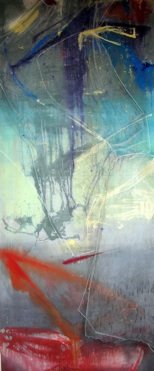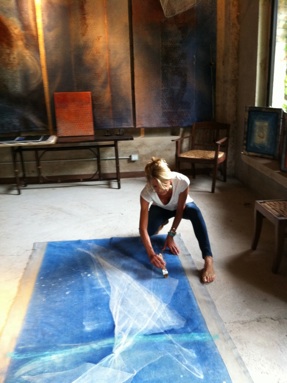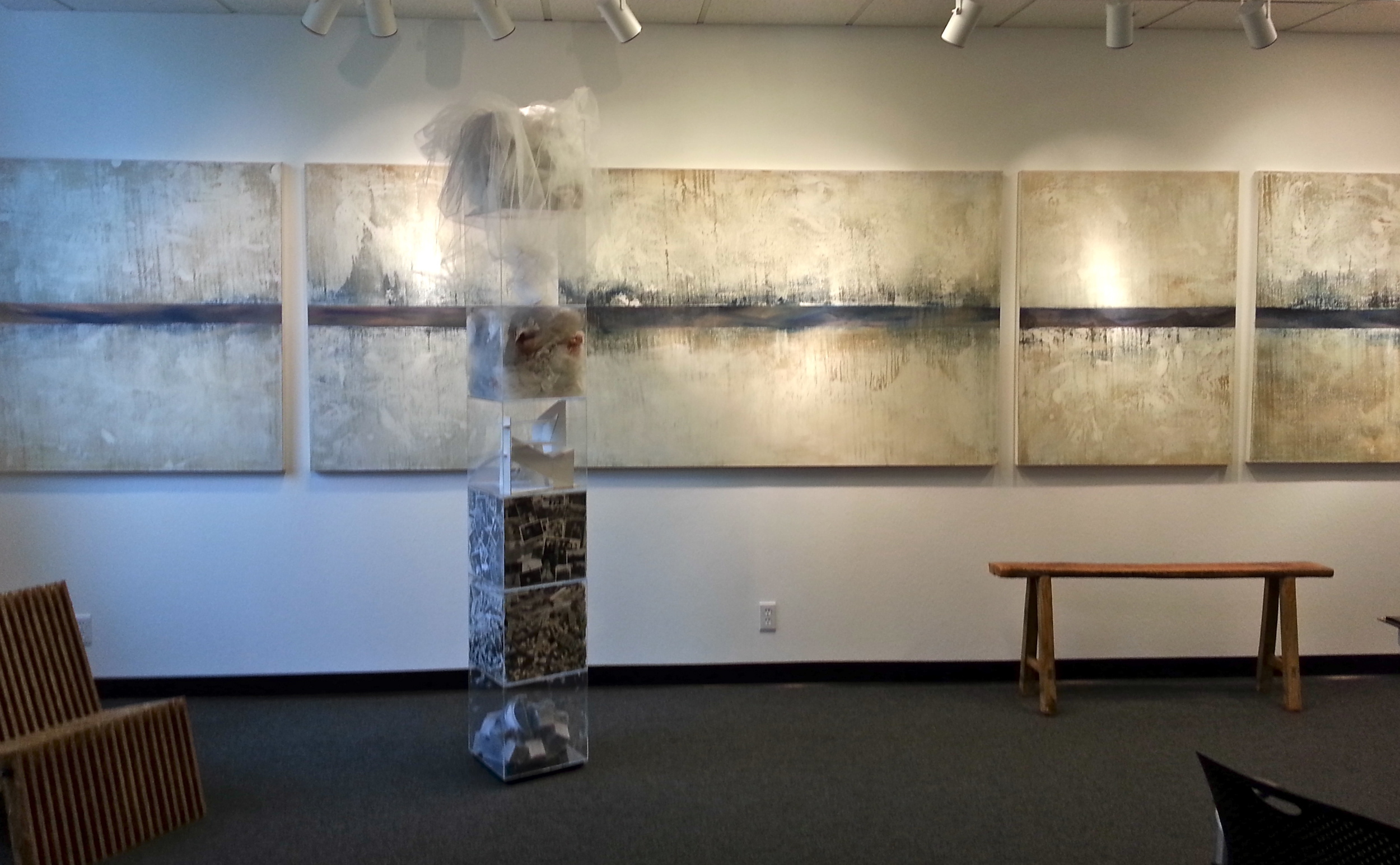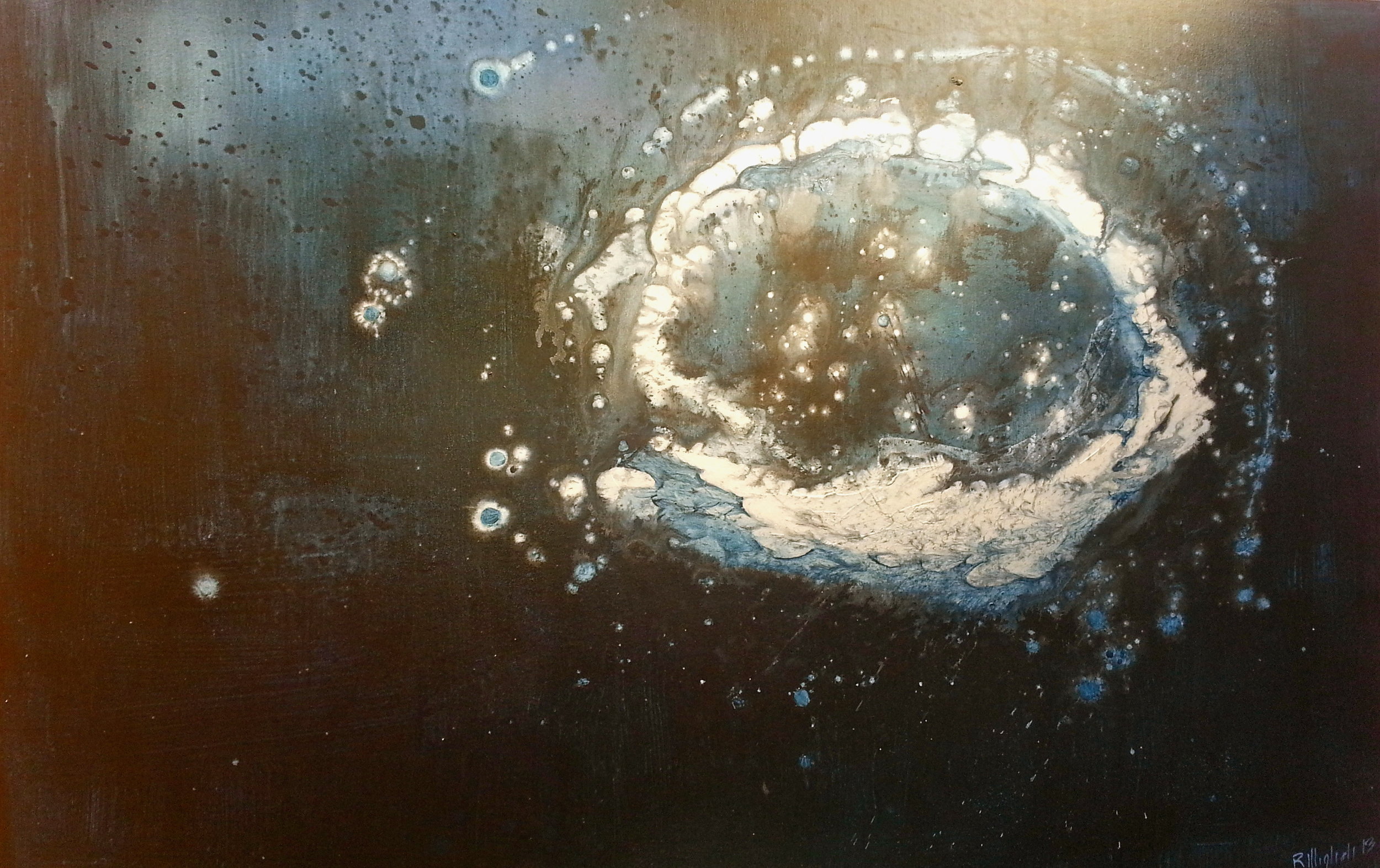About the artist
Rita Miglioli is an Italian-born art graduate of Liceo Artistico Foppa and in Architecture from Politecnico Milano. She has worked as an artist, textile and interior designer in New York, and has lived and worked in San Diego since 1984. She raised two children and worked in the family business, but has been painting and making art all along. Her work is in private and corporate collections, and has been featured in group and solo exhibitions in US and Europe.
She believes art and life are inseparable, and her works are visual representations of her thoughts. Her work explores extremes of the broadest spectrum of events—physical and emotional— while discovering new techniques, materials and subjects. She has a long-time fascination with the nature of the universe, its constant fluctuation and its temporary reality.
Artist Statement:
Making art is like listening to the part of me that needs the attention. The me that thinks and feels: the happy, sad, afraid, excited, angry or quiet me. The materials, the style and the technique I use support the intent, and are the tools for its realization–anything goes if it accomplishes the objective.
Versione Italiana
Completati gli studi accademici al Liceo Artistico V. Foppa di Brescia e Architettura al Politecnico di Milano, Rita Miglioli si trasferisce a New York. Mentre lavora come textile designer nel Garment Center, frequenta gallerie, visita musei, conosce artisti e dipinge esplorando temi e materiali diversi. Assorbe le tendenze d’avanguardia artistica americana, ampliando il gia’ profondo interesse per l’arte contemporanea ed astratta. Tuttora vive e lavora, dividendo il suo tempo, tra la California e l’Italia.
Rita Miglioli crede che arte e vita siano inseparabili. I suoi lavori sono rappresentazioni visive dei suoi pensieri. Esplora attraverso la pittura, scultura, installazione e video un discorso complesso sulla vita nei suoi estremi—fisici ed emozionali—con immagini cosmiche e astratte di un universo che e’ in costante flusso e cambiamento.
Temi ricorrenti sono: da dove arriviamo, chi siamo, e dove andiamo. In parole piu’ grandiose: cosmologia, filosofia e mortalita’. Esplora materia e anima: la loro fisicita’ e comportamento e la loro centralita’ all’esistenza umana. La materia ha un inizio—e se finisce, dove?
Images come from memories of places or events and they become a reference that provide a reassuring feeling of time continuity. They create a sense of comfort that eases the stress of life’s fragility as an illusion of immortality. They become structures of transition to a different reality and to another way of seeing and thinking.
Versione Italiana
Le immagini nascono da ricordi di posti e avvenimenti e diventano un riferimento che procura un senso rassicurante di continuita’ del tempo. Creano un senso di conforto che attenua la preoccupazione della fragilita’ della vita quasi come fossero un’ illusione di immortalita’. Le immagini diventano strutture di transizione a una realtà' diversa e ad un altro modo di vedere e di pensare.
The Path of Memory, 2014, and The Structure of Memory 2009
In the path of memory each individual's unique trace runs parallel to and crosses the paths of others as they move through time, creating a memory structure that influences events in our lives, our culture, our history. Along that path of memory its structure and lessons are reflected in our choices, thoughts, and actions. If we believe that our path of memory begins at birth, grows wide and deep in the mind, and ends when life ends, the question is: “Can memories live outside our minds? And how?”
Geyser, 2013
The series “Material Splendor,” explores the four classical natural elements (earth, water, fire, and air) and their manifestations: rocks, shells, vapors, liquids, gasses, and all that is visible and tangible. The work captures the mental process and the philosophical and psychological explorations that create and define the dream-like images in this series.
“Metamorphosis 5” is inspired by the beauty and dancing energy of fire in multiple hues and consistencies. The circular forms reflect the constant cycle of creation and destruction.The imagined spectacle of the flame changes, and blends with the earth or with the air, and when extinguished returns to them for continuity.
“Metamorphosis 4” postulates a remote space beyond our heliosphere in which alternating depths of darkness and light delineate imagined transformations of visible and dark matter, energy, time and space itself.
Even through its many changes, all of nature will continue to exist; therefore the nature of matter is immortal, even if it were reduced to a single speck of dust. A rock is washed by a river (water), sculpted by wind (air) or liquefied in volcanic transformation (fire), yet still retains its essence as a part of earth.
“Geyser 1” and “Geyser 2” try to capture the surreal mood I felt last fall when visiting Yellowstone National Park. The silvery light grays, deep blues, and purplish pink reflect the amazing natural phenomenon of vapors, steam, and hot water shooting out from within the earth.
The continuity of the universe is reality—birth as the beginning of life and death as its end are only human conventions, as is the apparently irreversible flow of time. All is, was, and will be forever. The illusion of the linear life is not the reality. Instead, life is a sequence of ephemeral events, and measured time is the tool we have created to organize them.
Consciousness is part of that continuum, and that is why it cannot be extinguished: it is already part of the whole. Each person’s consciousness existed before birth and continues after death but in different forms, each of which is part of the whole, the continuum. The images in this show are about change, transformation, metamorphosis.
SCIENCE AND ART: A REVIEW OF THREE SIGNIFICANT ART PIECES IN SAN DIEGO AND GENOA, ITALY
by Robert P. Metzger
Interpretations of scientific ideas by artists is not new. Many issues of The Sciences, the New York Academy of Sciences’ very interesting but, sadly, discontinued magazine, carried reproductions of paintings with scientific themes. Leonard Shlain in his book, Art and Physics. Parallel Visions in Space, Time and Light, writes of visual artists and scientists approaching an understanding of some concepts of physics from two different directions which can be melded an improved understanding of the idea. In 2014, due to serendipity, I was able to experience three different events in which artists interpreted concepts of light and structure in our universe.
My interest in physics and cosmology in art began in August with a chance visit to the Museo d’Arte Contemporanea a Villa Croce, (The Museum of Contemporary Art at Villa Croce) of Genoa, Italy. There I experienced an exhibition entitled: Cosmic Jive, the Spider Sessions by Tomás Saraceno. “Experienced” is the correct word to use, as will be seen. First, I present a word about the artist:
Tomás Saraceno is an up and coming Argentinian artist now based in Germany who appears to specialize in avant-garde exhibitions showing great creativity. I suggest having a look at pictures of some of his works, including one with people suspended in a clever arrangement of ropes, ladders and scaffolds hanging from a ceiling. Simply look at Google under “Tomas Saraceno” to see many pictures of his art. Pictures of interest relating to the Villa Croce exhibition that I discuss here are found at: www.villacroce.org/mostra/cosmic-jive- tomas-saraceno. Look at the pictures; the commentary is in Italian.
In Genoa, Saraceno worked with neuro-biologists and physicists to produce art using the basic premise that both the structure of galaxies in space and the structure of neural networks are similar to spider webs. The entire museum was taken over for this show. On the first floor were several hundred reprints of pages from Nature, Science and other important science journals which covered areas of physics, cosmology and neurology relevant to the exposition. I read some of these for about 30 minutes and then ascended the staircase to the second floor. There I was handed a flashlight before entering the first room of the exposition. The room was covered with black material and (obviously) was completely black. Strange music sounded occasionally; the flashlight was totally useless. I searched the room for a few minutes but found nothing other than the entrance to a similar room. I passed through this to a third room, again in total darkness, to finally arrive at a room, still black, with a large illuminated web of two lobes in a shape that vaguely resembled an enlarged brain with a diffuse spinal cord. I understood from my initial readings that the arrangements of galaxies in the cosmos or neurons in the nervous system might follow similar arrangements as those making up the web. The dark rooms symbolized that most of the universe is empty space.
Leaving the “web” room, I passed through two more blackened empty rooms until arriving at a room in which it was impossible to escape an intense white light. A second web structure was illuminated in this room. At a door, the museum custodian awaited the return of his flashlight.
This exhibition was so well done that I find myself to this day still considering the lessons and philosophical consequences of new developments in cosmology. It also made me more able to recognize the scientific aspects of two other works of art I found by serendipity in San Diego.
I attended the world premiere of the violin concerto “Fragile Light” by the San Diego Symphony’s associate composer David Bruce. The music is beautiful on its own, but a pre-concert presentation alerted me that Bruce’s depiction of light in differ- ent settings was more than impressionism; it also incorporated some thoughts about light from physics. Later, I read more about the composition and learned that Bruce’s inspiration for the concerto came in part from reading Nobel-laureate physicist Frank Wilczek’s book The Lightness of Being with the goal of attempting to “improve his understanding of the universe”. He wrote that the first two movements of his concerto were about the interactions of light with earth itself and the interactions of earth and light seen by astronauts. Bruce wrote that the music of the 3rd movement described the behavior of light as it spread throughout space; I, myself, saw it as an interpretation of the behavior of light during the first stages of the formation of the universe.
Almost at the same time, I came across a series of paintings which I interpreted as depicting the artist’s view of cosmological events. These paintings by Rita Miglioli may be seen at the UCSD Faculty Center (until February 10, 2015). In particular, her Metamorphosis seems to depict Miglioli’s interpretation of scientific theories. Below is Metamorphosis 4, shown with the artist’s permission.
Metamorphosis 4, 2013 - 48 x 72 inches
I immediately interpreted this work as depicting a cosmic event, perhaps a very early moment in the formation of the universe, perhaps a supernova. So, apparently does Miglioli who writes Metamorphosis 4 “postulates a remote space beyond our heliosphere in which alternating depths of darkness and light delineate imagined trans- formations of visible and dark matter, energy, time and space itself”. It seems the artist and the scientist can approach descriptions of the same concepts from different points of view. For more information about the paintings and thoughts of Rita Miglioli, see: www.ritamiglioli.com.










